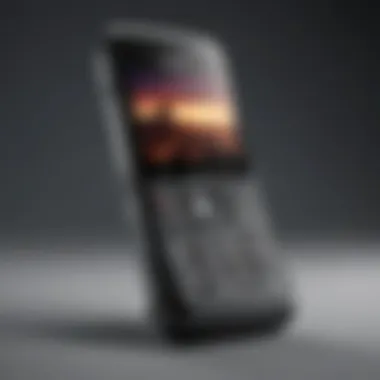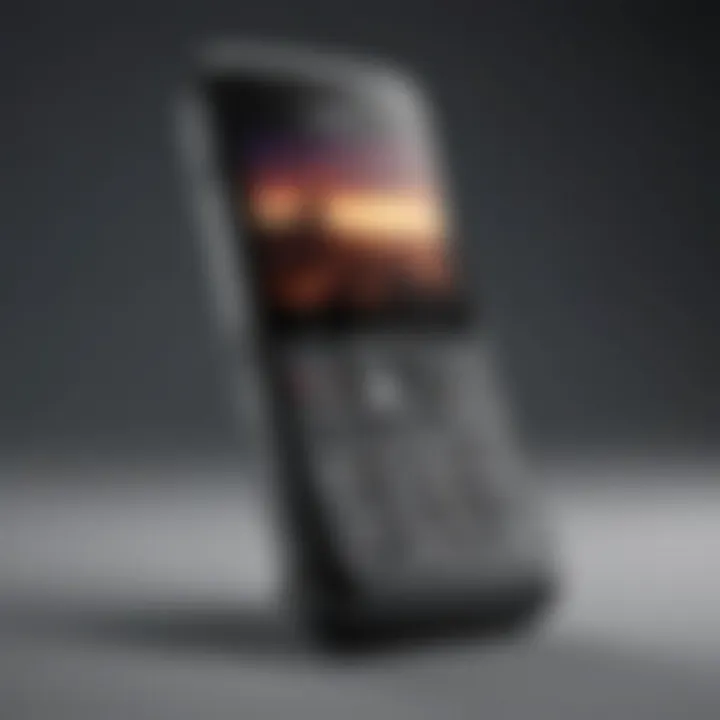The Flip Phone Comeback: Rethinking Mobile Devices


Intro
The resurgence of flip phones in today's mobile market may seem odd at first glance. However, it reflects deeper shifts in consumer priorities and technological capabilities. While smartphones have dominated for over a decade, the renewed interest in flip phones is driven by advancements that appeal to both nostalgic users and new generations alike. The revival of these devices is not merely about aesthetics; it embodies a broader cultural change towards simplicity and functionality.
As we delve into this growing phenomenon, we will explore the various elements contributing to the renewed appeal of flip phones. Key aspects include technological advancements, market demographics, and their impact on mobile gaming. Each factor provides a layer of understanding regarding why flip phones are becoming a viable choice despite the smartphone saturation.
One might consider how this trend will evolve over time. Will flip phones adapt further with ever-changing technologies? Or will they carve out a unique market segment focused on discrete and efficient communication? In the following sections, we aim to paint a comprehensive picture of this emerging flip phone phenomenon, highlighting important insights for today’s mobile users and enthusiasts alike.
Prologue to Flip Phones in Contemporary Mobile Technology
The resurgence of flip phones in the current mobile landscape is worth examining. These devices have evolved from their classic forms into modern gadgets that offer a unique blend of nostalgia and utility. This section will explore the significance of flip phones today, their key features, and what makes them appealing in an era dominated by smartphones.
Historical Context of Flip Phones
Historically, flip phones were significant in the evolution of mobile technology. They gained massive popularity in the early 2000s due to their compact nature and convenience. Popular models like the Motorola Razr and Samsung's various designs changed how people interacted with phones. The hinge mechanism allowed for a smaller form factor while protecting the screen. However, with the rise of smartphones in the late 2000s, the flip phone market saw a drastic decline.
However, the impact of flip phones during their peak is still felt today. Their user-friendly interface and durability made them popular, especially for communication purposes. People valued their simplicity over the increasingly complex smartphones. Reflecting on this context enriches our understanding of why flip phones are making a comeback now.
Rising Popularity of Foldable Devices
Today, the foldable device market is experiencing robust growth. Consumers are drawn to the versatility these devices offer. The combination of a compact design with expanded screen real estate addresses a fundamental need for many users. Products like the Samsung Galaxy Z Flip and Motorola Razr revival have captured the interest of both tech enthusiasts and casual users.
These modern flip phones incorporate significant technological advancements. Innovations in display technology, including flexible OLED screens, have made these devices more appealing. Consequently, the functionality of flip phones now aligns more closely with user demands for multitasking and media consumption.
Also, the nostalgia factor cannot be ignored. Many users who grew up with flip phones have fond memories associated with them. This emotional attachment plays a role in their renewed attraction. The current models not only evoke memories but also meet modern-day expectations for performance and aesthetics.
Key Features of the New Flip Phones
The resurgence of flip phones in today's market is not just a nostalgic revival; it is a response to evolving user needs and advancements in technology. Key features of modern flip phones portray the blend of form and functionality, capturing the attention of a diverse audience. These features, particularly display technology innovations, camera capabilities, battery life, and operating system adaptations, define the modern flip phone experience.
Display Technology Innovations
The display technology in new flip phones represents a significant leap forward from older models. Many are now equipped with flexible OLED screens, offering vibrant colors and deeper contrasts compared to traditional LCD displays. This allows users to enjoy richer media consumption and better viewing angles. Flexible displays also enable the designs to be more compact without compromising usability. Screen durability has also seen improvement with Gorilla Glass, providing resilience against scratches and drops. Such advancements cater to users who prioritize aesthetics and functionality in their devices. Additionally, a larger outer display allows for quick notifications and interactions without needing to unfold the phone, enhancing user convenience.
Camera Capabilities
Camera functionalities in flip phones have also evolved extensively. Modern devices integrate high-resolution sensors, multi-lens setups, and advanced computational photography features. Users can expect better low-light performance and enhanced image stabilization. Brands like Samsung and Motorola have incorporated features like night mode and portrait effects, making these smartphones competitive with traditional flagship devices. This aspect appeals particularly to mobile gaming enthusiasts who enjoy sharing their experiences through social media. Moreover, front-facing cameras often excel in these models due to the device's unique form factor, making them ideal for selfies and video conferencing. The integration of AI also allows for real-time enhancement in photography.
Battery Life and Performance
Battery life remains a crucial factor for any mobile device. The latest flip phones are designed with efficiency in mind, utilizing better battery technology and software optimization to ensure prolonged usage. New lithium polymer batteries offer greater capacity while remaining lightweight. Many devices can last an entire day with moderate use, which is a noticeable improvement from older models. Additionally, fast-charging capabilities have made it easier for users to recharge their devices rapidly, a necessity for those on the go. For gamers, this means longer uninterrupted gaming sessions without anxiety over battery drain. The performance of these devices is typically powered by state-of-the-art processors that handle demanding applications efficiently, further enhancing battery usage.
Operating System Adaptations
The operating systems of contemporary flip phones are tailored for a refined user experience. Android remains the predominant platform, but its interface has been customized to fit the unique form factor of flip phones. Features like split-screen capabilities and dual-window multitasking are designed to take advantage of the foldable display. This innovation permits easier navigation and a smoother user experience. Additionally, software support for popular gaming apps ensures that users can engage in mobile gaming without limitations. Moreover, regular security updates and user-friendly updates keep these devices aligned with user expectations and current trends.
Comparative Analysis: Flip Phones Vs. Smartphones


In the discourse on modern mobile devices, the comparative analysis of flip phones against smartphones stands as a vital element. This section scrutinizes the unique characteristics of flip phones and smartphones, shedding light on their respective user experiences, functional limitations, and advantages. In assessing these two categories of devices, it becomes evident that each caters to distinct user needs and preferences, providing insights into their evolving roles in the mobile landscape.
User Experience
User experience plays a crucial role in determining device preference. Flip phones offer a tactile, compact design that appeals to consumers seeking simplicity. They often prioritize call quality and battery longevity over extensive applications. This design philosophy resonates with users who value straightforward communication and fewer distractions. The act of flipping open the device can provide a satisfying physical interaction, which some users find appealing.
On the other hand, smartphones deliver a vastly different user experience. They feature larger screens, enabling rich interactivity through touch. Users can seamlessly engage with various applications, browse the internet, and access multimedia content. The adaptability of smartphones facilitates a multi-functional approach, where one device serves as a camera, a gaming console, and a communication tool. However, this complexity sometimes overwhelms users who prefer focused tasks.
Functional Limitations and Advantages
Both flip phones and smartphones present distinct functional limitations and advantages.
Advantages of Flip Phones:
- Durability: Many flip phones are designed to endure rough handling. Their clamshell design protects screens from scratches.
- Battery Life: Due to limited processing power and screen-on time, flip phones often boast superior battery life.
- Reduced Distractions: With a focus on core functionalities, users experience fewer distractions from notifications and apps.
Limitations of Flip Phones:
- App Ecosystem: Flip phones typically support fewer applications. This restricts functionalities primarily to calling, texting, and basic media.
- Screen Size: The smaller display limits web browsing and media consumption, making them less suitable for tasks requiring extensive screen interaction.
Advantages of Smartphones:
- App Diversity: Smartphones offer an expansive range of applications, from productivity tools to complex games, appealing to a broad audience.
- Multimedia Capabilities: Large screens enhance media consumption and gaming experiences, catering to a varied user base that prioritizes visual content.
Limitations of Smartphones:
- Battery Drain: The functionality of smartphones can lead to rapid battery depletion, especially during intensive use.
- Complexity: The overwhelming array of features may deter users who seek simplicity and ease of use.
"Understanding these differences helps users make informed decisions based on their personal preferences and lifestyle needs."
Demographic Appeal of Flip Phones
The appeal of flip phones in today’s mobile device market cannot be overlooked. They have made a notable comeback, drawing attention from various demographic groups. This section will analyze why flip phones are becoming relevant again, particularly focusing on the characteristics of their target audience and the trending market insights.
Target Audience Characteristics
The primary audience for modern flip phones can be diverse, ranging from tech-savvy individuals to those seeking simplicity. Young adults and teenagers are increasingly drawn to the nostalgic aspect of flip phones. They appreciate the retro vibe, as these phones remind them of earlier mobile styles and experiences within family environments. For older generations, flip phones represent a practical choice. Many older users favor user-friendly interfaces and reduced functionalities. This segment often desires connectivity without overwhelming features, epitomized by the simple call and text functions most flip phones provide. Additionally, busy professionals see value in maintaining a distraction-free communication tool. Users can prioritize essential interactions without the allure of social media and apps found in smartphones. Therefore, the characteristics of the target audience lean toward those valuing convenience over complexity, fostering a unique niche in the crowded mobile device spectrum.
Market Trends and Insights
The market for flip phones is showing promising trends that signify their increasing acceptance among consumers. According to recent market analyses, sales of flip phones have increased relative to traditional smartphones. Consumers are becoming more aware of the benefits that flip phones provide: affordability, durability, and simplicity. Some key insights include:
- Affordability: Flip phones typically come at lower price points compared to flagship smartphones, making them appealing for budget-conscious buyers.
- Durability: Often equipped with features such as ruggedness, these devices are resistant to damage from drops and spills, attracting a practical customer base.
- Simplicity: Many users readjusting to digital life amidst distractions find pure communication without apps reassuring. The less complicated user interface promotes a healthier relationship with technology.
"The flip phone resurgence indicates a broader cultural shift towards simplicity in our tech interactions."
Market dynamics favor brands that can effectively navigate this simplification trend. Successful implementations of technology in flip phones—like improved camera systems and enhanced battery life—also play a crucial role. The combination of nostalgia, practicality, and evolving technology positions flip phones favorably amid current mobile device trends. As the demographic interest continues to grow, flip phones may find an even firmer footing in the mobile market landscape.


The Influence of Flip Phones on Mobile Gaming
The influence of flip phones on mobile gaming cannot be overstated in this modern context. With their resurgence, flip phones are now equipped with features that cater to gaming enthusiasts. They offer a unique blend of portability and functionality, which appeals to a segment of users that values simplicity without sacrificing gaming capabilities. The compact design of flip phones makes them highly suitable for on-the-go gaming experiences.
Compatibility with Gaming Applications
One of the critical factors for the success of flip phones in the gaming sector is their compatibility with gaming applications. Major platforms like Android have evolved significantly, allowing for a broader range of applications to function seamlessly on these devices. Manufacturers such as Samsung and Motorola have produced flip models that run on Android OS, which supports a variety of popular games. This compatibility allows users access to top-rated games like PUBG Mobile and Call of Duty: Mobile.
Moreover, developers are increasingly recognizing the potential of flip phones as viable gaming devices. Games can now be optimized to run on the unique hardware configurations of these phones. For instance, some games provide tailored interfaces that suit the foldable screens of flip phones, ensuring an enjoyable gaming experience. The ability to download and run applications from the Google Play Store grants flip phone users a diverse library of games that was previously unavailable to them.
Gaming Performance Metrics
When discussing the influence of flip phones on mobile gaming, performance is a crucial consideration. Metrics such as device responsiveness, graphics quality, and processing speed are essential indicators of how well a flip phone can handle gaming tasks.
Modern flip phones are equipped with robust hardware components. This includes powerful processors and ample RAM, which enhance gaming performance. For example, the Motorola Razr 5G features a Snapdragon 765G chipset, providing solid performance for mobile gaming. Additionally, the battery life of these devices has improved. Users can enjoy longer gaming sessions without interruption.
To illustrate, consider the gaming benchmarks for the popular flip phones:
- Samsung Galaxy Z Flip 4
- Motorola Razr 5G
- CPU: Snapdragon 8+ Gen 1
- RAM: 8GB
- Average Frame Rate in Games: 60fps
- CPU: Snapdragon 765G
- RAM: 8GB
- Average Frame Rate in Games: 45-50fps
These metrics demonstrate that flip phones can compete favorably with traditional smartphones in gaming scenarios. Users are gradually beginning to embrace these devices for gaming, thanks to their convenience and dependability.
Overall, the emergence of flip phones offers a new avenue for mobile gaming without losing the practicality that users desire.
Consumer Reception of Modern Flip Phones
Consumer reception plays a vital role in understanding the success and evolution of modern flip phones. With advancements in technology, the resurgence of these devices is not merely a fleeting trend; it indicates a shift in consumer preference and functionality requirements. As mobile gaming enthusiasts seek new experiences, flip phones present unique features that cater to both casual use and gaming.
Reviews and User Feedback
User feedback is crucial in shaping the narrative around modern flip phones. Many consumers have shared their thoughts on platforms like Reddit and Facebook, noting the blend of nostalgia and modernity these devices offer.
- Design and Functionality: Users frequently appreciate the compact design and ease of use. The ability to fold the device creates a sense of portability that larger smartphones lack. This has resonated particularly well with users who value simplicity in their mobile experience.
- Camera Performance: Modern flip phones often come equipped with impressive camera capabilities. Users note that the dual-screen setup facilitates better selfies and video calling, which has become essential in today’s social media-driven environment.
- Battery Life: Feedback often highlights superior battery performance in comparison to traditional smartphones. This extended battery life is a significant selling point, especially for gamers who require long-lasting devices during their prolonged gaming sessions.
- Software Usability: Many reviews focus on the smooth user interface and the adaptation of operating systems which enhances performance. Users find that the integration of mobile gaming with these devices is seamless.
Sales Performance Analytics
Analyzing sales data provides a comprehensive view of how well modern flip phones are being received in the market. Recent trends show a notable uptrend in sales figures. According to industry reports, the sales of flip phones have increased by a significant margin.
- Market Segment Growth: The demographic targeting has widened, pulling users from various age groups. Both younger consumers and older generations are investing in these devices due to their distinctive charm and usability.
- Comparison with Smartphones: The sales figures of flip phones have steadily gained ground against the smartphone market. In particular, firms like Samsung and Motorola have reported impressive sales data, indicating a viable alternative to traditional smartphones.
- Regional Variations: Sales analytics also reveal regional preferences. For example, markets in Asia have shown an increased inclination toward flip phones as lifestyle devices, whereas North America closely follows with its own growing trends.
Consumer feedback, combined with sales analytics, unveils a compelling narrative for the flip phone market, illustrating not only its appeal but also its potential longevity in a smartphone-dominated world.
Challenges Facing the Flip Phone Market


The resurgence of flip phones in today's technology landscape is noticeable. However, as with any market, there are distinct challenges that these devices must overcome to gain widespread acceptance. Understanding these challenges is crucial for both manufacturers and consumers. The issues revolve primarily around competition, technological limitations, and shifting user preferences.
Competition with Traditional Smartphones
The primary challenge for flip phones is competing with traditional smartphones. Devices like the Apple iPhone and Samsung Galaxy series dominate the market, thanks to their extensive features, ecosystem integration, and brand loyalty. Many consumers view smartphones as the standard. They provide larger displays, high-resolution cameras, and access to a wide selection of applications.
Traditional smartphones create a perception that flip phones are outdated or less capable. Despite innovations aimed at revitalizing flip phones, the marketing message must be clear. These new models are not just outdated devices reimagined, but modern gadgetry suited to current needs.
Some of the key competitors in this battle include:
- Apple iPhone: Renowned for user experience and app availability.
- Samsung Galaxy series: Known for high-performance devices and camera capabilities.
- Google Pixel lineup: Offers advanced software integration and features.
To persuade consumers, flip phone brands must emphasize their unique advantages, such as durability, simplicity, and innovative designs that cater to a niche market.
Technological Limitations
Moreover, technological limitations present another hurdle for flip phones. While many modern flip phones boast impressive specs, they still lag in several areas critical to the average user.
- App Ecosystem: The app selection for flip phones is not as robust as that available on conventional smartphones. While manufacturers like Motorola and Samsung strive to provide essential apps, many popular ones remain unavailable or run poorly. This leads to a lack of interest from tech-savvy consumers who rely on those applications.
- Camera Quality: Although advances have been made in camera capabilities, flip phones typically do not match the quality offered by flagship smartphones. High-resolution photography, night mode, and video capabilities are essential features for many users.
- Connectivity Features: Many flip phones may not support the latest connectivity features, such as 5G. Users in metropolitan areas may gravitate towards smartphones that enable rapid mobile internet and low-latency experiences.
"Advancements in foldable and flip phone technologies will need to address both app limitations and hardware capabilities to remain competitive."
Further insights into the evolution of the mobile market can be explored on sources like Wikipedia or Britannica. Each of these sources highlights the ongoing trends and technological developments shaping consumer preferences.
Future Prospects for Flip Phones
The relevance of discussing the future prospects for flip phones in this article cannot be overstated. As the mobile landscape evolves, so does consumer preference. Flip phones have captured the attention of both tech enthusiasts and casual users, marking a shift in how we view mobile devices. This section explores the future trends and innovations that might shape flip phones and their integration into daily life.
Predicted Trends in Mobile Technology
Recent trends indicate a growing inclination towards more compact and functional devices. Expect to see flip phones with enhanced display technologies, such as OLED and AMOLED. These advancements will improve visual experiences while consuming less battery. Moreover, 5G connectivity is becoming the standard, allowing for enhanced data speeds. This will be critical for both everyday use and gaming.
Additionally, artificial intelligence is expected to play a significant role. Features like intelligent camera enhancements can transform the photography experience, allowing users to take high-quality pictures with ease. Coupled with better voice recognition systems, these innovations enhance user interactivity.
Consumers are increasingly looking for privacy-conscious devices. The appeal of flip phones lies partly in their simplicity and reduced distractions. Future models will likely feature better security protocols, such as biometric recognition and improved encryption methods.
Potential for Gaming Innovations
The potential for gaming on flip phones is vast and exciting. As the mobile gaming market continues to grow, developers are keenly aware of the need for tailored experiences on smaller devices. The integration of gaming-specific features could revolutionize how players engage with these devices. Flip phones are also likely to have more powerful graphics processors, enabling smoother gameplay even on compact forms.
Moreover, many modern flip phones are being designed with larger screens when opened. This allows for a more immersive gaming experience. Consider games where tactile feedback enhances gameplay. This can be crucial for engagement and user retention.
Additionally, cloud gaming services are gaining traction. Platforms like Google Stadia or Xbox Cloud Gaming enable users to play demanding games without needing high-end hardware on their devices. This trend could include flip phones as viable options for gaming due to the advancements in network speeds and reduced latency.
> "The shift back to flip phones is not just nostalgia; it's a reaction to the digital overload many feel with contemporary smartphones."
Ending
The re-emergence of flip phones signifies more than just a nostalgic revival; it marks a pivotal shift in mobile technology and consumer preferences. As examined throughout this article, modern flip phones blend style, functionality, and innovative technology, attracting a diverse range of users eager for a practical alternative to conventional smartphones.
Considerations surrounding this trend extend beyond mere aesthetics. The unique benefits of flip phones include their compact design, improved durability, and user-centric features. These devices often focus on essential functionalities without the distractions commonly associated with smartphones. Thus, they cater to users seeking simplicity in an increasingly complex mobile environment.
Moreover, the impact of flip phones on mobile gaming cannot be overlooked. With advancements in display technology and processing capabilities, these devices present new opportunities for game developers. They can create gaming experiences tailored specifically for a folding interface, enhancing user engagement and interactivity. Consequently, the future of mobile gaming may evolve in ways previously unimagined.
"The resurgence of flip phones represents both a nod to the past and a leap towards future innovations that could redefine mobile usability."



